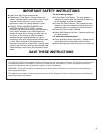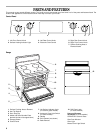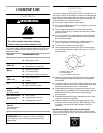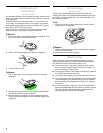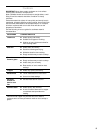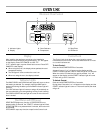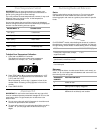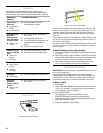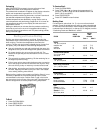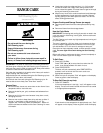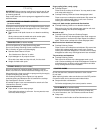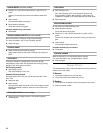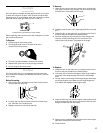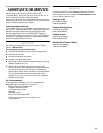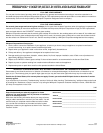
15
Cleaning
IMPORTANT: Before cleaning, make sure all controls are off and
the oven and cooktop are cool. Always follow label instructions
on cleaning products.
Soap, water and a soft cloth or sponge are suggested first unless
otherwise noted.
EXTERIOR PORCELAIN ENAMEL SURFACES
(on some models)
Food spills containing acids, such as vinegar and tomato, should
be cleaned as soon as the entire appliance is cool. These spills
may affect the finish.
■ Glass cleaner, mild liquid cleaner or non-abrasive scrubbing
pad:
Gently clean around the model and serial number plate
because scrubbing may remove numbers.
STAINLESS STEEL (
on some models)
Do not use steel wool or soap-filled scouring pads.
Do not use Cooktop Polishing Creme or abrasive cleansers.
Rub in direction of grain to avoid damaging.
■ Stainless Steel Cleaner & Polish:
See “Assistance or Service” to order.
■ Liquid detergent or all-purpose cleaner:
Rinse with clean water and dry with soft, lint-free cloth.
■ Vinegar for hard water spots
CERAMIC GLASS
(on some models)
Do not use steel wool, abrasive powder cleansers, chlorine
bleach, rust remover or ammonia because damage may occur.
Always wipe with a clean, wet cloth or sponge and dry thoroughly
to prevent streaking and staining.
Use Cooktop Polishing Creme regularly to help prevent
scratches, pitting and abrasions and to condition the cooktop.
See “Assistance or Service” to order.
A Cooktop Scraper is also recommended for certain soils. See
“Assistance or Service” to order.
Light to moderate soil
■ Paper towels or clean damp sponge:
Clean while the cooktop is still warm. You may want to wear
oven mitts while doing so.
Sugary spills (jellies, candy, syrup)
■ Cooktop Scraper:
Clean while the cooktop is still warm. You may want to wear
oven mitts while doing so.
■ Cooktop Polishing Creme and clean damp paper towel:
Clean as soon as cooktop has cooled down. Rub creme into
surface with a damp paper towel or soft cloth. Continue
rubbing until white film disappears.
Heavy soil, dark streaks, specks and discoloration
■ Cooktop Polishing Creme or non-abrasive cleanser:
Rub product into soil with a damp paper towel or soft cloth.
Continue rubbing until white film disappears.
Burned-on soil
■ Cooktop Polishing Creme and Cooktop Scraper:
Rub creme into soil with damp paper towel. Hold scraper as
flat as possible on surface and scrape. Repeat for stubborn
spots. Polish entire cooktop with creme and paper towel.
Metal marks from aluminum and copper
■ Cooktop Polishing Creme:
Clean as soon as cooktop has cooled down. Rub creme into
surface with a damp paper towel or soft cloth. Continue
rubbing until white film disappears. The marks will not totally
disappear but after many cleanings become less noticeable.
Tiny scratches and abrasions
■ Cooktop Polishing Creme:
Rub creme into surface with a damp paper towel or soft
cloth. Continue rubbing until white film disappears. Scratches
and abrasions do not affect cooking performance and after
many cleanings become less noticeable.
CONTROL KNOBS
Do not use steel wool, abrasive cleansers or oven cleaner.
Do not soak.
When replacing knobs, make sure knobs are in the OFF position.
On some models, do not remove seals unders knobs.
■ Soap and water or dishwasher:
Pull knobs straight away from control panel to remove.
COIL ELEMENTS
(on some models)
Do not clean or immerse in water. Soil will burn off when hot.
For more information, see “Coil Elements and Burner Bowls”.
■ Damp cloth:
Make sure control knobs are off and elements are cool.



